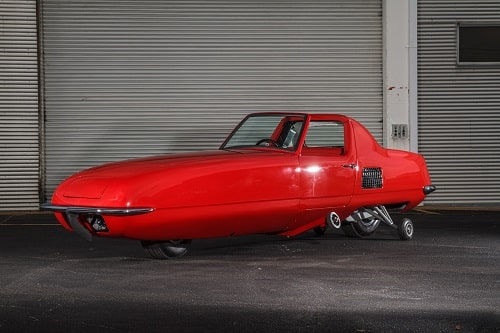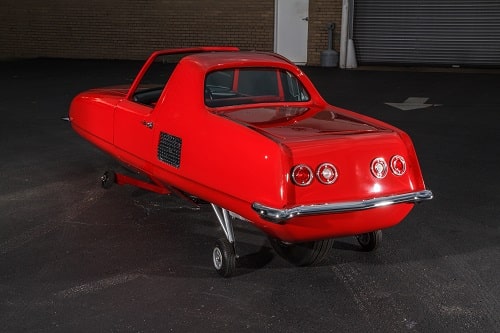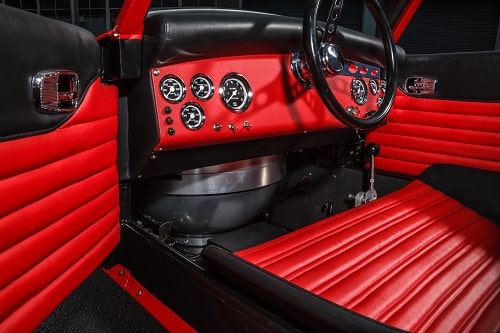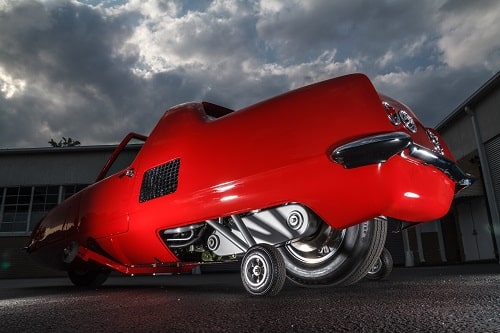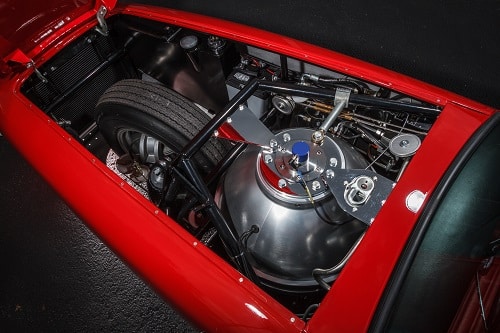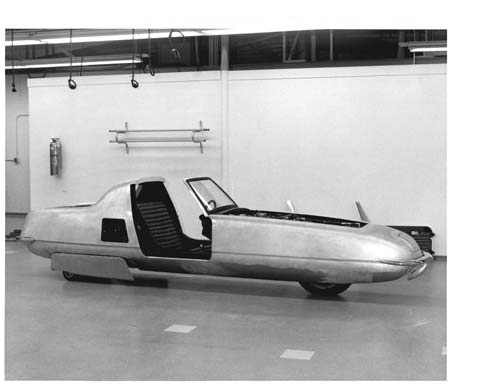
Gyro-X-1967
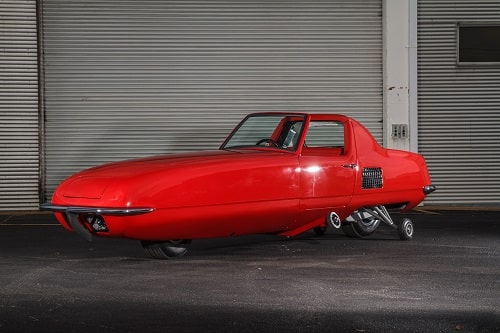
The brainchild of Alex Tremulis, famous stylist and Automobile Hall of Fame inductee, and Thomas Summers, a gyroscope expert, the Gyro-X is a two-wheeled, gyroscopically-stabilized prototype vehicle constructed in 1967. Proposed as a possible solution for future transportation, the two-wheeled vehicle provided many thought-provoking ideas for revolutionizing transportation.
Why only two wheels? Tremulis and Summers suggested that a two wheeled vehicle could be more efficient than its larger four-wheeled counterpart. Smaller and lighter weight means it can use a smaller engine. The Gyro-X was reported to reach speeds of 125 mph using an 80 hp Mini Cooper S engine. Also, the gyroscope’s stored kinetic energy would be harnessed as an additional power source in future gyro vehicles! The aerodynamic body design reduced wind resistance, while half the number of tires reduced road drag. As far as drivability, two wheels made for greater maneuverability, like that of a motorcycle. While a two-wheeled automobile may at first glance seem unsafe and definitely unstable, the Gyro-X made use of a single 22- inch hydraulically-driven gyroscope which stabilized the vehicle, allowing it to “swoop through 40 degree banked turns without tipping.”
The Gyro-X was displayed for the first time at “The Wonderful World of Wheels”, an exhibit at the 1967 New York International Auto Show. Of the vehicles presented, the Gyro-X was included, offering a sneak peek into the possible future of the automobile. In September of that year, the cover of Science and Mechanics magazine featured the car on the cover, exclaiming its merits as “impossible to skid or flip”, “125 mph on 2 wheels with 80 hp”, and “can bank at 40 degrees!”
Although the Gyro-X was promoted as the future of vehicles, and there is a video of it running, witnesses recount that at high speeds, over 70 mph, the vehicle was unstable. It is possible the engineering was too complex and needed more development to perform as advertised and the company, which went bankrupt, ran out of funds to perfect the product.
Regardless of the actual events that transpired, Gyro Transport Systems, Inc. went under around 1970 and the Gyro-X never went into production.
The 50-Year Journey
In a letter written in July of 1970 to Gyro Dynamics Corporation, parent company of Gyro Transport Systems, Alex Tremilus mentions that he is greatly disturbed, most notably by the fact that the Gyro-X vehicle was parked outside, uncovered, and exposed to the elements and vandalism. He further mentions that had he been consulted, he could have arranged for the vehicle to be loaned to a museum for safekeeping until the courts decided its final disposition.
The Gyro-X next appears January 24th 1975 in a Thousand Oaks, California News Chronicles article featuring Tom Summers’s three-wheeled gyro car. Summers added the third wheel for licensing purposes in the State of California, as vehicles over 1500 lbs. could not be considered motorcycles. The article also mentions how he was trying to get a group of Las Vegas investors to produce the vehicle. It appears again in 1978 on the cover of Gyrovehicles- a New Concept in Land Transportation by Thomas O. Summers. This publication refers to the vehicle as the Gyroglide. Next, the continued hope for gyro vehicles to take off is further evidenced in a 1981 letter from Tremulis to Summers, who writes, “Perhaps someday you will meet with a group of great vision. IF SO your contribution to the art will be the achievement of our century. May 1981 be the year of the GYRO.” From here the Gyro-X disappears until July 1994, when it is used by Paul Richardson and Reta Lee, doing business as Futuristic Customs Unlimited of Las Vegas, as collateral for an unpaid loan and relinquished to John Needham, dba John Windsor. By this point in time, the vehicle has been transformed into a VW- powered three- wheeled car and the gyroscope is long gone. It sits on Needham’s property for 10 years before he decides to get it running. In 2009 he posts a video of the barely recognizable Gyro-X on YouTube asking for any information about the vehicle. He then sells it to Houston, Texas collector Mark Brinker, who in December of 2011 sells the vehicle to Lane Motor Museum.
Lane Motor Museum Restoration
Although the vehicle arrived as a much-modified three wheeler with no gyroscope, the goal was to restore the prototype to its original condition. The restoration process has involved years of research and hard work to piece the car, and its history, back together. Now, after 50 years, the fully restored vehicle is returning to the spotlight.
For a detailed video on how the Gyro-X works, click here: https://www.youtube.com/watch?v=tqGB1zOICfg
Photos of the restored Gyro-X Courtesy Wes Duenkel
Specifications:
Manufacturer: Gyro Transport Systems
Country of Origin: Ridgecrest, California, United States
Drivetrain Configuration: Rear-engine, rear-wheel drive
Engine: Water-cooled 1275cc, transverse inline-four; 80hp
Transmission: 4-speed manual
Top Speed: 125 mph (claimed)
Years of Production: 1967
Number Produced: 1
Original Cost: $750,000 (2015: $5.6 million)

